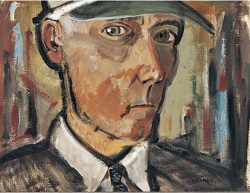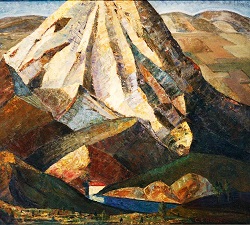by Jess Kimmel ’25
One of the many programs created by Franklin D. Roosevelt as a part of the New Deal was the Works Progress Administration, or the WPA. First launched in 1935, the WPA was instrumental in providing jobs for the millions of Americans who were left unemployed as a result of the Great Depression. Like other New Deal initiatives, this program largely revolved around the creation and renovation of roads, public buildings, and other infrastructure. According to sociologist Robert D. Leighninger, these programs “had an enormous and largely unrecognized role in defining the public space we now use.”
While thinking about the WPA often evokes images of manual labor, many of its projects also provided opportunities for actors, musicians, writers, and artists. From the sculptures and murals commissioned to publicize and promote the collectivist values of the Roosevelt administration, to the ethnomusicology research conducted by the Federal Music Project, creatives in the New Deal era found themselves valued and sought out to a level that had seldom been reached before in American history. One such creative was Portland painter Charles Heaney, a man known for defying and redefining artistic tradition.
Born to a working-class family in Oconto Falls, Wisconsin in 1897, Charles Heaney went through nearly sixteen years of life without seeing a mountain. Not unusual, perhaps, for a Midwesterner, though certainly notable in hindsight for an artist whose greatest works would include no small number of paintings depicting Northwestern mountain peaks. While traveling by train with his mother and sisters to their new home in Portland, Heaney would get his first glimpse of the Rocky Mountains, even the foothills of which overwhelmed him with their majestic beauty. He didn’t yet consider himself an artist, but that memory of mountains would serve as a font of inspiration for him years later.
As a young man in Portland, Charles Heaney worked briefly as a laborer, before soon realizing that such a career would be unsustainable for him. He found his first artistic calling as an engraver in 1916,
before going on to study painting and printmaking at the Portland Museum Art School. His art career reached its heights in the 1930s, which saw his work evolve from simple pastoral prints to more emotionally complex paintings during his partnership with expressionist painter C.S. Price. The New Deal was in full swing at that time; while the heart of the Depression initially found him digging sewers for the Civil Works Administration, Heaney was able to find federal employment as an artist in 1934 with the Public Works of Art program, and later with the WPA in 1937.
Charles Heaney was commissioned by the WPA to create prints and paintings to furnish the program’s many public buildings. This provided him with full-time work as well as an opportunity to further gain renown as an artist. Somewhat ironically, Heaney described the Depression as a Renaissance of American art due to the unprecedented level of government interest and support, and there were few projects that more clearly demonstrate this demand for art than Timberline Lodge.
Built right on the slope of Mount Hood, Timberline Lodge is a historic inn and ski resort that is easily one of the crowning achievements of the Works Progress Administration. It is in fact “the only twentieth century building of its size constructed and furnished entirely by hand with original craft work,” writes Rachael Griffin,

Timberline Lodge, as stylized on the cover of The Builders of Timberline Lodge, an informational booklet published by the WPA in 1937.
longtime curator of the Portland Art Museum and founding member of the Friends of Timberline, in a 1979 guide to the lodge. Construction on Timberline began in the summer of 1936 and was completed in just over a year, a timeframe that would still be considered impressive today. Yet, what makes Timberline so significant to American art is the careful and intentional way that it was furnished with original art: sculptures, carvings, mosaics, textiles, and paintings.
It is here, in the lodge’s mezzanine gallery, that one of Charles Heaney’s most powerful works, The Mountain, hangs, in the company of other great Cascadian artists. An oil painting on canvas, it is barely able to contain the imposing figure of Mt. Hood itself. This painting was completed in September of 1937, just in time for Timberline’s dedication. It would not be Heaney’s last work depicting mountains, which became an emergent theme throughout much of his later work. As a Regionalist and Romantic artist, they were something of a stylistic cliche for him. But beyond that, it stands to reason that the draw he felt towards the peaks of Oregon was steeped in the memory of mountains that had long ago welcomed him to the West.
Traces of the WPA and its sister programs remain scattered throughout Oregon, serving as a stalwart reminder of the things that a people united can accomplish. In addition to Timberline Lodge, other scenic landmarks such as the McLoughlin Promenade, Silver Falls State Park, and Salem’s own Waterfront park owe their existence to the New Deal public works programs.
More information about Charles Heaney and his association with the WPA can be found in Willamette University’s Pacific Northwest Artists Archive, maintained by the joint collaboration of the university Archives and the Hallie Ford Museum of Art. Much of the material on Heaney is located in the archived research files of Roger Hull, Professor Emeritus of Art History, who wrote monographs and organized retrospective exhibitions on the subject of Heaney and other Northwest artists.
Sources:
Charles Heaney, 1902-2006, bulk: 1916-2004, Series III. Roger Hull Research Files on Pacific Northwest Artists, WUA065. Willamette University Archives and Special Collections.
Biographical Statements, Resumes, & Chronologies, Box: 3, Folder: 39
Completed Monograph, 2005, Box: 3, Folder: 20
Timberline Lodge, 1937-2004, Box: 4, Folder: 17
Hale, Jamie. “10 Oregon landmarks built by workers during the Great Depression.” The Oregonian, https://www.oregonlive.com/life-and-culture/g66l-2019/12/4b496903728641/10-oregon-landmarks-built-by-workers-during-the-great-depression.html
Leighninger, Robert D. (May 1996). “Cultural Infrastructure: The Legacy of New Deal Public Space”. Journal of Architectural Education. 49 (4): 226–236



